Apocalypse of Blue bottle Coffee | the glory and price of moving from a street stall to an international market
The physical store of Blue bottle Coffee in San Francisco. Figure / Joshua Rainey Photography@Shutterstock

The Blue bottle of Coffee opened in Tokyo in February 2014. It started in San Francisco. The Blue bottle, known as the "Apple of the coffee industry," officially went international, giving the world a new understanding of the coffee culture deeply cultivated in San Francisco. Blue bottles have swept through major media and social networking sites, and stores in San Francisco, New York and Tokyo have become places of pilgrimage for tourists, but this menacing "third wave of coffee" has returned to San Francisco, where it originated. What else is there besides a blue bottle? What are the social conditions and cultural trends that bring out the delicate and rigorous taste and culture of blue bottle coffee? How does the Blue bottle Coffee look like in San Francisco now and in the past?
What is the "third wave of coffee" (Third Wave of Coffee)?
In San Francisco, the "third wave of coffee" led by Blue bottle Coffee has ushered in a new era of high-quality coffee (maintaining a niche market, at least in the start-up stage). The concepts of independent craftsmanship, small-scale production, and local ready-to-eat that San Francisco has always been proud of have been thoroughly integrated into the coffee industry, or perhaps coffee into a spirit of local art and craftsmanship.
Compared with the instant coffee culture represented by the first wave of instant coffee, the second wave of deep roasted coffee and metropolitan cafe culture initiated by coffee chains such as Starbucks and Peet's, the third wave of coffee regards coffee as wine tasting, emphasizing that each coffee bean has its own unique flavor depending on the variety, producing area, climate, treatment and brewing methods. In addition, unlike the re-baking methods that were popular in the past, blue bottles of coffee are mostly light and medium-roasted to bring out the clear sour aroma and fruit flavor of top-notch beans. Such a change is precisely the critical taste buds of San Francisco people, treat coffee with the rigorous approach of "wine tasting" and slow drinking attitude, and completely reform the world's view of coffee.
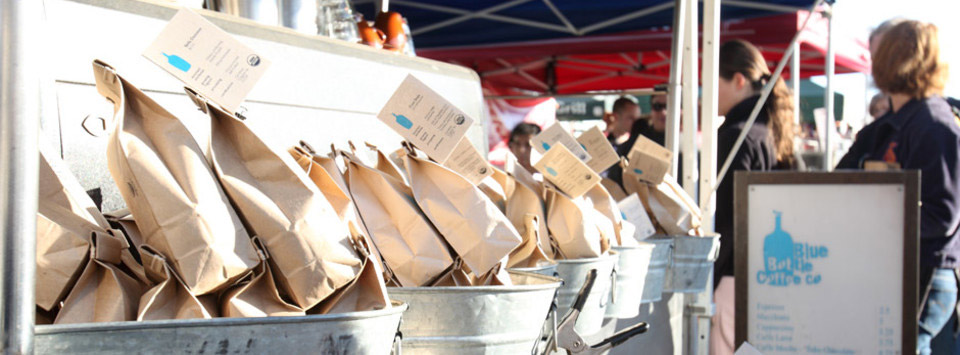
Blue bottle of coffee. Photo / Blue bottle Coffee official website
San Francisco, nourishing blue bottle coffee out of the international hotbed
In San Francisco, coffee is already a part of life and culture. With an area of only 46 square miles, it has more than 300 coffee shops, or six per square mile, making it the city with the highest concentration of independent coffee brands in the United States. There are relatively few people who drink Starbucks in San Francisco, at least walking on the streets of the community, and it doesn't happen very often.
As a matter of fact, San Francisco is one of the first-tier cities in the United States, where it is more difficult for large coffee shops to seize land. Why?. In terms of objective conditions, San Francisco has the highest rent in the United States. According to a rent survey released by Zumper at the end of 2015, the top 10 cities with the highest one-bedroom rents, San Francisco, Oakland and Silicon Valley, were all on the list, and San Francisco outperformed New York. This is only the number of residential areas. In recent years, in the Mishen district (also known as the Mixun district) where the tech upstart and Wenqing cafes gather, and the Noe Valley district in the west, the one-bedroom apartment costs at least US $3500 (about NT $110000) a month, not to mention how frightening the rental burden for commercial use can be.
──, the birthplace of Blue bottle, is the rich and mixed East Bay of San Francisco.
Then there is the soil of humanities and food fashion. From the hippie wave in the 1960s, coupled with the Italian immigrants moving to the North Beach, hippie cafes and cultural cafes that boast Italian or American baking, to the boutique cafes springing up like bamboo shoots after a spring rain, San Francisco has always been an important town at the top of the waves. Peet's Coffee & Tea, a coffee chain that closely follows Starbucks in the United States, that is, Berkeley, which originated in the east of the Bay area, makes special reference to the historical background of the East Bay because the seeds of the coffee trend dedicated to brewing excellent quality were already planted in the East Bay as early as 1966. If you ask the locals, nine out of ten will proudly say that Bitz Coffee insists, shows a moderate store, and maintains the style of a community coffee shop, which is very much in line with the cultural characteristics of San Francisco Bay.
East Bay has a great impact on the diet and coffee territory of San Francisco. Just south of Berkeley, there used to be a blue-collar city, ── Oakland (Oakland), which is the birthplace of Blue bottle Coffee. Oakland is an interesting place with a mixture of dragons and snakes, and to the north is the academic town of Berkeley, where house prices and shopping taxes are quite high in the Bay area. This area is the most densely populated area of African Americans in Northern California, with many factories, warehouses and abandoned land, and has become the best hinterland for San Francisco's saturated development. Just like many people who worked in San Francisco at that time, because they could not afford the high rent, they rented a house in Oakland and took the BART (Rapid Transit) to the city during the daytime. It took only 15 minutes to drive, but it was a big difference between Harlem and Manhattan. The start-up story of Blue bottle Coffee also has some elements of San Francisco's modern gold rush dream.
Start from Scratch, starting from scratch
Americans like to say "Start from Scratch". San Francisco, which emphasizes the entrepreneurial spirit of starting from scratch, has put this slang into practice more thoroughly. On December 13, 2003, Blue bottle gained some word of mouth after selling coffee on a trailer in Oakland for a year and a half, and founder James Freeman was finally able to realize his biggest dream since selling coffee. ── entered San Francisco.
The venue for the first trial was the Ferry Building Farmers' Market (Ferry Building Marketplace), a gourmet hall in San Francisco. The vendors stationed in this top fashionable farmer's market were all temporary choices. For the blue bottle, it was a front-line battlefield for first-time testing skills and accumulating experience.
The market hawks but opens a shop. James Freeman, the headmaster and bell ringer, gets up from his home in East Bay at 3:45 every Saturday morning to "reload" all kinds of coffee equipment at the bakery of Temescal (Note 3) in Oakland, and then to the Thrifty Drugs across the street to buy ice cubes. The traffic of the Bay Bridge is usually not very good, and many farmers and hawkers in East Bay and other places also rush into the city at this time. For Freeman in a shabby Peugeot, the war really began, and he had to be at the ferry building at least 6:30 to officially welcome visitors when the market opened at 8 o'clock, and business might not be good if he happened to run into a cold, cloudy day in San Francisco.
It happened to be a typical hazy day in December, wet, cold and rainy, and the crowd was less than expected, but when Freeman handed over the first cup of slow-dripping single-origin black coffee to the guests, he was deeply inspired by the throbbing of personal interaction with customers to experience the good coffee time.
Two years later, countless people carrying coffee equipment alone, the journey from East Bay to San Francisco no longer seems so far away. He started with a few helpers, and although he still had to work all the way until two o'clock in the afternoon to feed the roast chicken exchanged for four cappuccinos and a nearby vendor, he occasionally took a vacation.
At this time, business couldn't be better. Blue bottle became the most popular coffee shop in the farmer's market. Despite the long queue, he insisted on "cup hands dripping slowly", "never sell coffee beans that have been roasted for more than 48 hours", the signature "New Orleans Iced Coffee", powdered chicory (Chicory), a secret recipe he developed, special sweet smell and freshly brewed iced coffee. Special attention is paid to the technology of pinching and brewing. Unwittingly, under the spread of word-of-mouth, the word Blue Bottle has become a synonym for San Francisco people looking for high-quality, delicious coffee.
Show the store slowly and stick to the idea of starting up.
As you probably know the rest of the story, Blue bottle's first physical Coffee Kiosk (coffee shop) opened in Hayes Valley in 2005, leading the competition in the highly competitive San Francisco coffee circle with the use of single-origin, fresh, organic, high-quality coffee beans and the superb craftsmanship of cup hand dripping.
Blue bottle Coffee's first full-scale cafe did not welcome guests at Mint Plaza near the city until 2008. The store is still small, with long community table and backless high chairs, demonstrating Blue bottle's unique "standing food" culture rooted in the streets. Four large Japanese-made siphon pots (Syphon) are brightly sucked and spit; a cold drip coffee machine and a whole row of hand coffee utensils take 16 hours at a time, and the blue bottle accumulates silver bullets, making it more powerful. Doesn't the clerk usually urge the guest to decide what flavor to order? The whole blue bottle culture begins with eye contact with yuppie clerks.
Then, in 2009, Freeman returned to his former foothold "Ferry Building" to open a third physical storefront, and the coffee vendors outside were still operating as usual, this time with a permanent spot inside the building to satisfy diners who wanted to taste the blue bottle at any time. "this is another dream that I thought was impossible," Freeman recalled. "there are only two coffee shops in the whole ferry building, one is the Peet's mentioned earlier, and the other is the Blue bottle.

Inside the Blue bottle Coffee Ferry Building. Figure / kimberlytaylorimages
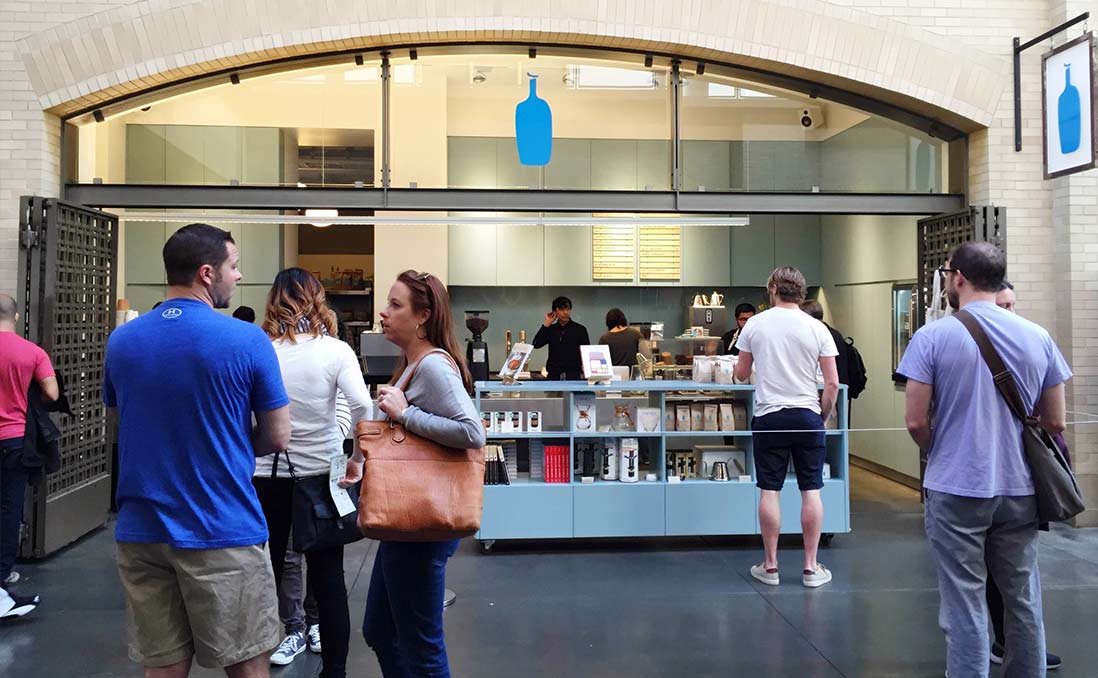
San Francisco Blue bottle Coffee exquisite coffee equipment and store furnishings. Photo / courtesy of Susan Wigg
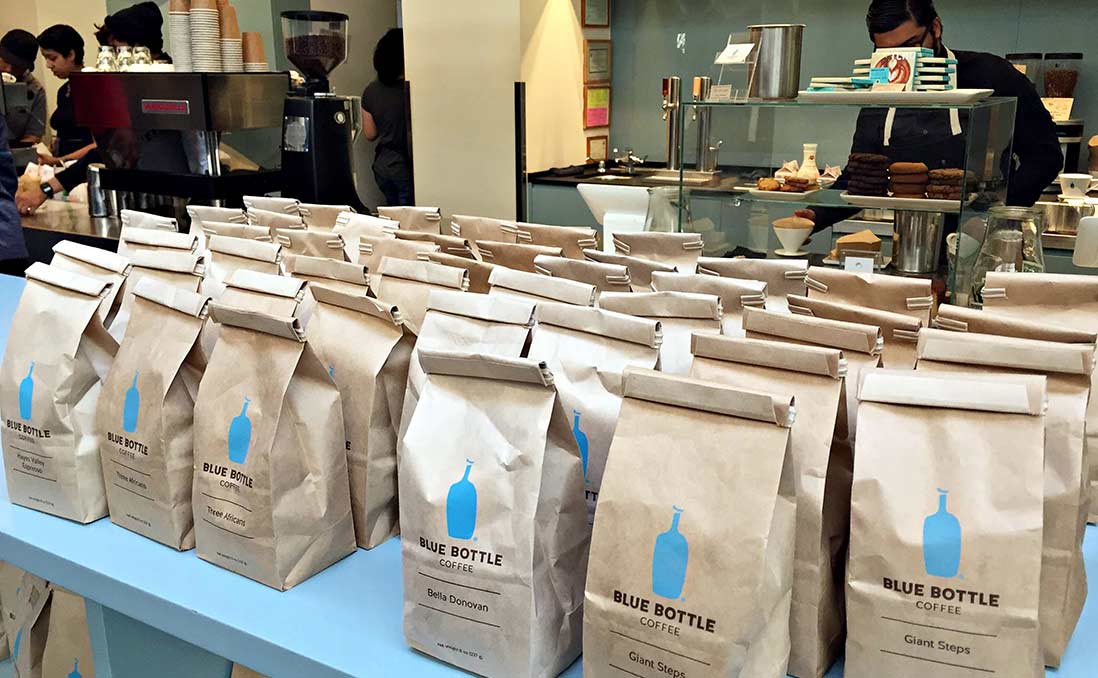
San Francisco Blue bottle Coffee exquisite coffee equipment and store furnishings. Photo / courtesy of Susan Wigg

San Francisco Blue bottle Coffee exquisite coffee equipment and store furnishings. Photo / courtesy of Susan Wigg

San Francisco Blue bottle Coffee exquisite coffee equipment and store furnishings. Photo / courtesy of Susan Wigg

San Francisco Blue bottle Coffee exquisite coffee equipment and store furnishings. Photo / courtesy of Susan Wigg
Step into art cakes and climb to boutique cafes
In May of the same year, Blue bottle made another big move, entering SFMOMA (San Francisco gallery), which is another epoch-making move on the road to the ultimate boutique coffee. Blue bottle shows ambition beyond coffee drinks. Caitlin Freeman, the owner's wife, is an ingenious pastry chef. Her 27 series of art desserts, inspired by SFMOMA's works of art, including classic works by Andy Warhol, Madis and Cindy Sherman, have been transformed into delicious and exquisite works of art that people can't bear to eat.
Although after the reopening of the SFMOMA renovation this year, Blue bottle Coffee lost to another Sightglass and was unable to enter gallery, which broke the hearts of countless San Francisco. Fortunately, these delicacies have been included in Caitlin's recipe "Modern Art Desserts."
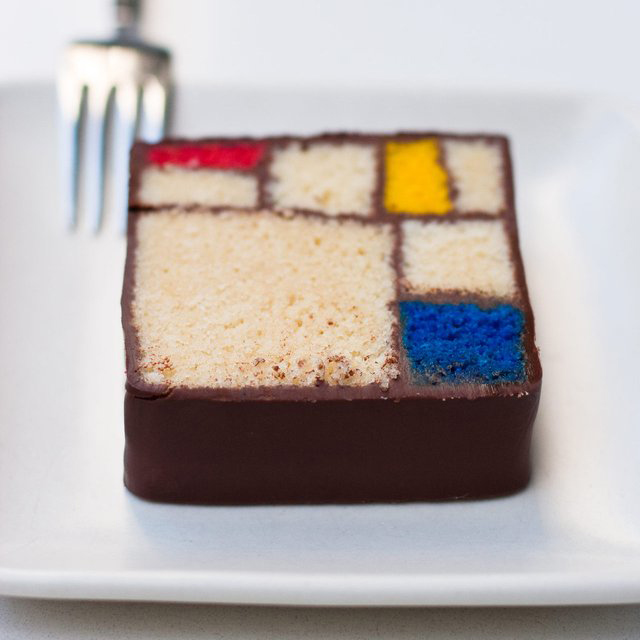
Mondrian cake came up with the works of Ellsworth Kelly, a master of abstract art. Figure / Fancy
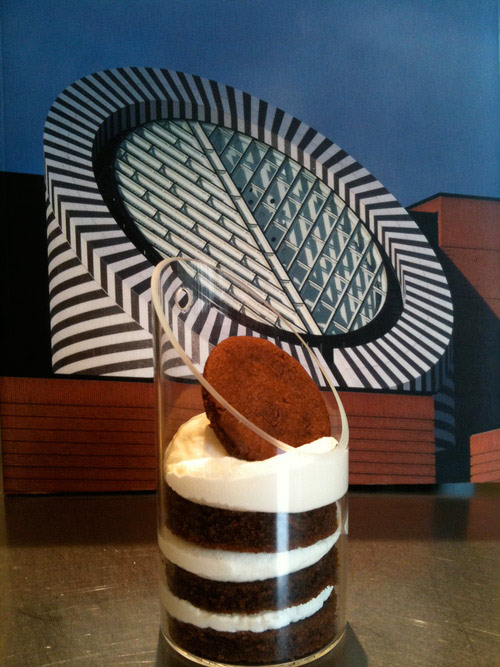
Dijkstra Icebox Cake is inspired by SFMOMA's iconic half-cone architecture. Photo / Leah Rosenberg photography

Dijkstra Icebox Cake is inspired by SFMOMA's iconic half-cone architecture. Figure / courtesy of Clay McLachlan
People in San Francisco are looking forward to Blue bottle's next project in the dessert field. After all, last fall, the dessert agency plan between Blue bottle and Tartine Bakery, a French dessert brand in San Francisco, came to an end, and people with good intentions speculated that Blue bottle still wanted to retain its autonomy in light snacks and give Caitlin Freeman, the landlady, a greater stage.
End the coffee channel agent, focus on brand direct marketing and easy-to-open cans of cold coffee
For Bay area residents who do not live in San Francisco, the rights and interests of coffee agents released to other access stores are precious after Blue bottle Coffee has gained a firm foothold.
The cost of opening a store directly is high, and many niche coffee brands with three to five years of market experience choose this method to make their brands and products reach more customers. As a result, I remember that before the fall of 2015, I could still see Blue bottle Coffee in some non-Blue bottle stores, the Ritz Hotel in the ski resort Lake Tahoe, the South Bay Silicon Valley Premium Shopping Mall Valley Fair, and the aforementioned Tartine Bakery in San Francisco.
But overnight, Blue bottle withdrew all access rights in the United States. Many senior hotel managers and Michelin chefs may be as heartbroken as I am, so they have to move closer to other coffee brands of the same class, such as Sightglass, Four Barrel and so on.
Blue bottle coffee's business strategy in terms of access changed to the introduction of portable paper canned coffee. It was the first to enter the organic supermarket chain Whole Foods in Junwan District in April 2014, choosing the classic New Orleans iced coffee as the first canned flavor, asking for US $3.99 (about NT $125). The result of the water temperature test is that the market is in short supply and is often out of stock. The original cold-soaked black coffee was launched in April 2016 and is now guaranteed at Blue bottle stores.
What do the old gold people think of such a change? Reaction poles. Through talking to baristas and customers at the Blue bottle Coffee Oakland headquarters and Tartine Bakery, I learned that many regular customers actually want Blue bottle Stay Small and Stay Local without going to other towns, quickly showing stores, or using customer turnover as an operational indicator, and so on. Because this is very likely to lose the original innocence and persistence, just imagine, when a coffee maker with only five branches adjusts his business strategy to expand direct stores overseas or in the United States as his primary goal, he takes care of local customers, or how can he preserve or adjust the initial market insistence?
The price of blood and tears of growth, cut down and retrain? The historic choice to evacuate the San Francisco Ferry Building
Then, one day last May, my friend said to me, "would you like to have the last cup of coffee of Blue bottle at the Ferry Building vegetable market this Saturday?" "I know that Blue bottle Coffee is different. The cup of hand-made coffee that came out of the Oakland trailer is now leaving the first place where I gained a foothold in San Francisco. Freeman's farewell note, written with romantic agony, was published on May 4, 2015, and many people in San Francisco who accompanied the Blue bottle to this day are as saddened as I am.
"The Ferry Plaza market was my graduate school, my gymnasium, my think tank, and my laboratory. Even though our drinks have never been more carefully prepared, sourced and roasted, we are at the point in our trajectory where our ambitions just don't fit outside the Ferry Building on Saturdays. "
The stalls in the ferry building market are my alma mater, my training ground, my cradle of thinking, and the experimental research center. Even after 11 years, our coffee is still as carefully collected, roasted and prepared as it was at first, but now a tipping point on this track is the market stall outside the ferry building on Saturday. there is no room for the ambition of blue bottle coffee. )
This is undoubtedly a decision made after a long and painful process. As a member of San Francisco, I don't know how long it will take for Blue bottle Coffee to develop and transform the world coffee culture, or that there are ambitious dreams that excite the team more than Tokyo showrooms. All I know is that on May 30 last year, the Blue bottle stall outside the San Francisco Ferry Building sold the most coffee ever, and the proceeds went to the non-profit CUESA Sustainable Agricultural Development Organization.
Freeman, who has not shown up for a long time, makes coffee himself and greets guests. This scene is a little unfamiliar and sentimental, which is different from the noisy and lively market taste in the past, but it is real and profound, and it is worth remembering forever in the history of coffee. After all, we may not be ready, but Blue bottle is ahead!
Note 1: the Bay Area generally refers to the cities surrounding San Francisco Bay, including San Francisco at the tip of the narrow peninsula, Berkeley and Oakland in the East Bay, and cities such as the Palo Alto Peninsula and San Jose in the south.
Note 2: the founding stronghold of Blue bottle Coffee in 2002 is located behind Dona Tomas, the Temescal Alley Mexican restaurant in Oakland today, with no physical storefront.
Note 3: Temescal is the oldest neighborhood in Oakland, located in North Auckland, next to Berkeley. This area is home to immigrants of different nationalities from all over the world. At present, African-American residents are still a large number. In recent years, Temescal Alley, which has been converted from old stables, has become a new cultural settlement, which is very popular with local hipsters.
Important Notice :
前街咖啡 FrontStreet Coffee has moved to new addredd:
FrontStreet Coffee Address: 315,Donghua East Road,GuangZhou
Tel:020 38364473
- Prev
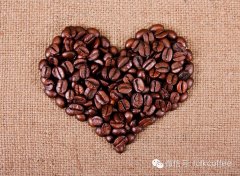
As a barista, what do you insist on coffee?
Everyone who loves coffee is the artist Ichiro Kawaguchi, a 101-year-old coffee master who only does one thing in his life, and that is to bake coffee beans! Born into a large family-seven sisters and two brothers-at the entrance to the Cafe deLAmbre Cafe in Ginza, Tokyo. He is a single man and has never been married. I still make my own breakfast every morning. His nephew lives downstairs.
- Next
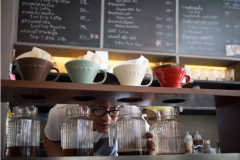
Deep good text | Commercial coffee people are comrades-in-arms or bad friends in high-quality coffee?
Those who are difficult to make boutique coffee will occasionally overlap with commercial coffee. People from moments or curious about boutique coffee will also come to explore the way. What they have in common is: 1. I don't think it is necessary to use electronic name for coffee. Based on my own experience, the adjustment is delicious. 2. I want to work together to roast coffee, but I know nothing about the producing areas and varieties of coffee. I have connections. I have money.
Related
- What documents do you need to go through to open a coffee shop? coffee shop coffee shop certificate processing process
- How to purchase Coffee beans in small Cafe how to choose a suitable supplier for domestic Coffee supply Company
- How to drink Starbucks Fragrance White Coffee? how to make Australian White Coffee? what Italian coffee beans are recommended?
- The Story of Flora Coffee: the name of Flora Coffee Bean and the implication of the Flowers on Florna Coffee
- How much does a cup of coffee cost? How much is the profit of a cup of coffee? What is the profit of the coffee shop in a year?
- Yunnan small Coffee, known as "fragrant Coffee", introduces the characteristics of Alpine Arabica Coffee producing areas in Yunnan, China
- 2023 latest Starbucks full menu price list how much is a cup of Starbucks coffee what is better to drink the most popular hot and cold drinks recommended
- Starbucks different kinds of Coffee Price list Starbucks menu 2023 Top Ten Best drinks in Starbucks
- Starbucks Spring praise Comprehensive matching Coffee Bean theme Story Packaging implication and taste description
- The cost of a cup of coffee latte American coffee cost price and selling price

